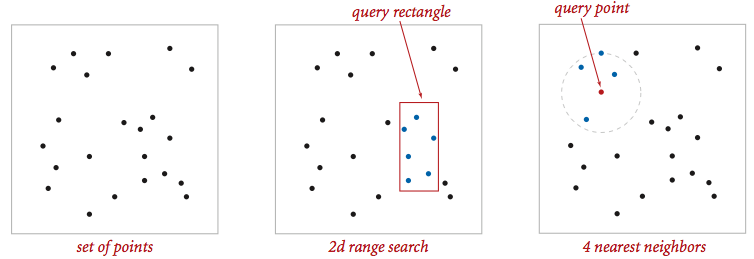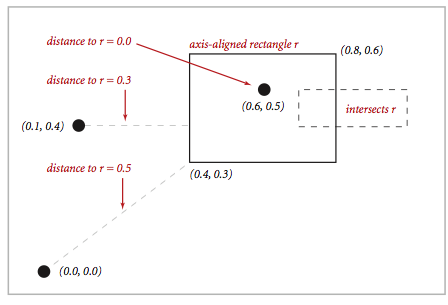

Geometric primitives.
To get started, implement two geometric primitives:
one for points in the plane and one for axis-aligned rectangles in the plane.

Write an immutable data type Point.java that implements the following API.
public class Point implements Comparable<Point> {
public Point(double x, double y) // construct the point (x, y)
public double x() // x-coordinate
public double y() // y-coordinate
public double distanceTo(Point that) // Euclidean distance between two points
public double distance2To(Point that) // square of Euclidean distance between two points
public int compareTo(Point that) // for use in a symbol table
public boolean equals(Object that) // does this point equal that?
public void draw() // draw to standard draw
public String toString() // string representation
}
Write an immutable data type RectHV.java that implements the following API.
public class RectHV {
public RectHV(double xmin, double ymin, // construct the rectangle [xmin, ymin] x [xmax, ymax]
double xmax, double ymax) // throw an exception if (xmin > xmax) or (ymin > ymax)
public double xmin() // minimum x-coordinate of rectangle
public double ymin() // minimum y-coordinate of rectangle
public double xmax() // maximum x-coordinate of rectangle
public double ymax() // maximum y-coordinate of rectangle
public boolean contains(Point p) // does this rectangle contain p?
public boolean intersects(RectHV that) // do the two rectangles intersect?
public double distanceTo(Point p) // Euclidean distance from p to closest point in rectangle
public double distance2To(Point p) // square of Euclidean distance from p to closest point in rectangle
public boolean equals(Object that) // does this rectangle equal that?
public void draw() // draw to standard draw
public String toString() // string representation
}
Thoroughly test your data types before proceeding.
Brute-force implementation. Write a data type PointSET.java that represents a set of points in the unit square. Implement the following API by using a red-black tree (using either SET or TreeSet).
public class PointSET {
public PointSET() // construct an empty set of points
public boolean isEmpty() // is the set empty?
public int size() // number of points in the set
public void insert(Point p) // add the point p to the set
public boolean contains(Point p) // does the set contain p?
public void draw() // draw all of the points to standard draw
public Iterable<Point> range(RectHV rect) // points in the set that are in the rectangle
public Point nearest(Point p) // nearest neighbor in the set to p (null if set is empty)
}
Your implementation should support insert() and contains()
efficiently, but not nearest() and range().
2d-tree implementation. Write a data type KdTree.java that implements the same API as PointSET, but using a 2d-tree instead of a red-black tree. A 2d-tree is a generalization of a binary search tree to two-dimensional keys. The idea is to build a binary search tree with points in the nodes, using the x- and y-coordinates of the points as keys in strictly alternating sequence.
insert (0.7, 0.2) insert (0.5, 0.4) insert (0.2, 0.3) insert (0.4, 0.7) insert (0.9, 0.6)
The prime advantage of a 2d-tree over a binary search tree is that it supports efficient implementation of range search and nearest neighbor search. Each node corresponds to an axis-aligned rectangle in the unit square, which encloses all of the points in its subtree. The root corresponds to the unit square; the left and right children of the root corresponds to the two rectangles split by the x-coordinate of the point at the root; and so forth.
Clients. You may use the following interactive client programs to test and debug your code.
Analysis. Analyze your approach to this problem giving estimates of its time and space requirements by answering the relevant questions in the readme.txt file. In particular:
Submission. Submit Point.java, RectHV.java, PointSET.java, and KDTree.java and any other files needed by your program (excluding those in stdlib.jar and algs4.jar). Finally, submit a readme.txt file and answer the questions.
This assignment was developed by Kevin Wayne.